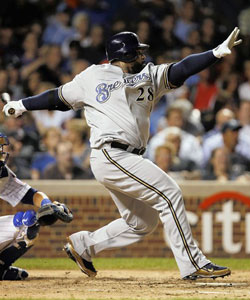 Sports Illustrated‘s Jon Heyman took an interesting approach to next year’s crop of elite free agents—Albert Pujols, Jose Reyes, and Prince Fielder—he polled a handful of agents and asked what price each player would go for. What he found wasn’t terribly surprising, if you follow these things closely. They predicted Pujols would go for the most, probably over $200 million, followed by Fielder and Reyes.
Sports Illustrated‘s Jon Heyman took an interesting approach to next year’s crop of elite free agents—Albert Pujols, Jose Reyes, and Prince Fielder—he polled a handful of agents and asked what price each player would go for. What he found wasn’t terribly surprising, if you follow these things closely. They predicted Pujols would go for the most, probably over $200 million, followed by Fielder and Reyes.
Pujols, despite the prevalence of Poo-Holes shirts in Wrigleyville, has been talked about as a potential target for the Cubs. But why not Fielder? Consider the numbers. Here are their averaged stats for the past four years (AVG/R/H/HR/OPS), including this year:
Fielder: .285/83/145/33/.950
Pujols: .319/98/159/36/.1020
Pujols is clearly the better hitter; he’s also widely considered a much better fielder, and the numbers (Fielder/Pujols) back that up.
But also consider the following. First, Pujols is 31; Fielder is 27. Broadly speaking, ages 26-28 are when players enter their prime years. Pujols is something of an exception, having basically had his prime from the day he entered the major leagues at 21, though he did improve slightly, insofar as such a thing is possible, at age 26. (You could argue that his age 23 year was his best: most hits, doubles, total bases, and highest on-base percentage.) At 29, he led the majors in runs, home runs, on-base percentage, slugging, and total bases.
Meanwhile, a lot of good players fall off after age 33. As Bill James put it: "The human body is like bread that won’t stop baking. Age 33 is about the age at which you KNOW the bread is getting over-done and you wish that you could turn off the oven, but you just can’t." Or, Tristan Cockcroft: "it’s clear a player’s prime runs about six or seven years, from ages 26 through 32." And if you go back through the league leaders in wins over replacement player over the past couple decades, you’ll find that plenty of hitters of all kinds were outstanding from ages 30-33: Kirk Gibson, Mike Schmidt, Wade Boggs, Ichiro Suzuki, Ricky Henderson, Jose Bautista.
Above 33? Barry Bonds (cough).
If you look at OPS, or on-base percentage plus slugging, time is a little bit better for hitters. Chipper Jones was great through age 36, as was Manny Ramirez and Mark McGwire. Derek Jeter, at a more wearying position, rebounded for a good age-35 year, but has declined since.
If the Cubs sign Pujols, they get the best hitter in baseball and one of the best fielders at his position, for the remainder of his prime. And since Pujols is a truly great hitter at a relatively forgiving position, his prime could last longer: 35? 36? Plus they get the best draw in baseball, which can’t be discounted for a team that’s worried about attendance. But they would also pay more, and would likely be locked into his contract until even the great Pujols fades. Not to mention the realistic possibility that the Cubs are a couple years out from contention.
Meanwhile, Fielder would probably save them several million dollars a year, money that could be put towards the Cubs’ greatest need, pitching. Last week they had the worst run differential in baseball—it’s improved since, now they’re only third-worst—mostly due to their horrific pitching. As of today they have the worst ERA and worst WHIP (walks+hits/innings pitched) in baseball, and have given up the most walks of any team.
One secret culprit for their walks: Jeff Samardzija, who’s walked an amazing 31 batters in 42 innings. The least innings of anyone who’s walked 32? Zach Britton, 93 innings. Samardzija has an ERA/WHIP of 4.25/1.49 despite an opponents’ batting average of .204, which is lower than Carlos Marmol’s. The list of likely available pitching free agents isn’t great—Edwin Jackson? Anyone?—but the Cubs need pitching depth as much as they need talent, and they could lose Matt Garza, arguably their only effective starter, or Carlos Zambrano, their only other semi-effective starter.
If anything, I’d be more excited for 2013, when a pile of good young to youngish arms may come on the market: Zach Grienke, Matt Cain, Cole Hamels, Jered Weaver, Anibal Sanchez, and Dan Haren, not to mention some good middle-of-the-rotation starters like Scott Baker, Kyle Lohse, and Shaun Marcum.
Photograph: Chicago Tribune


